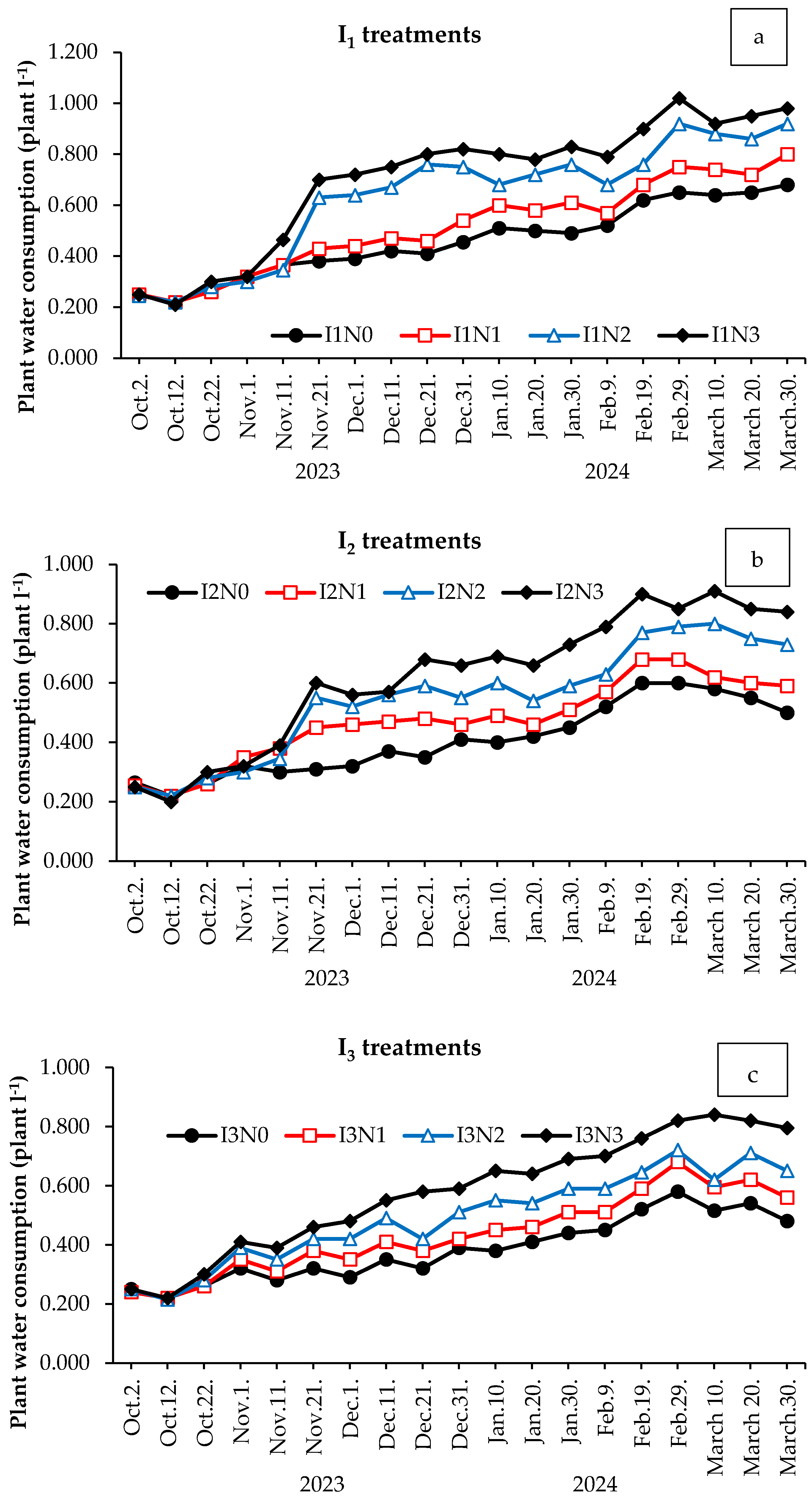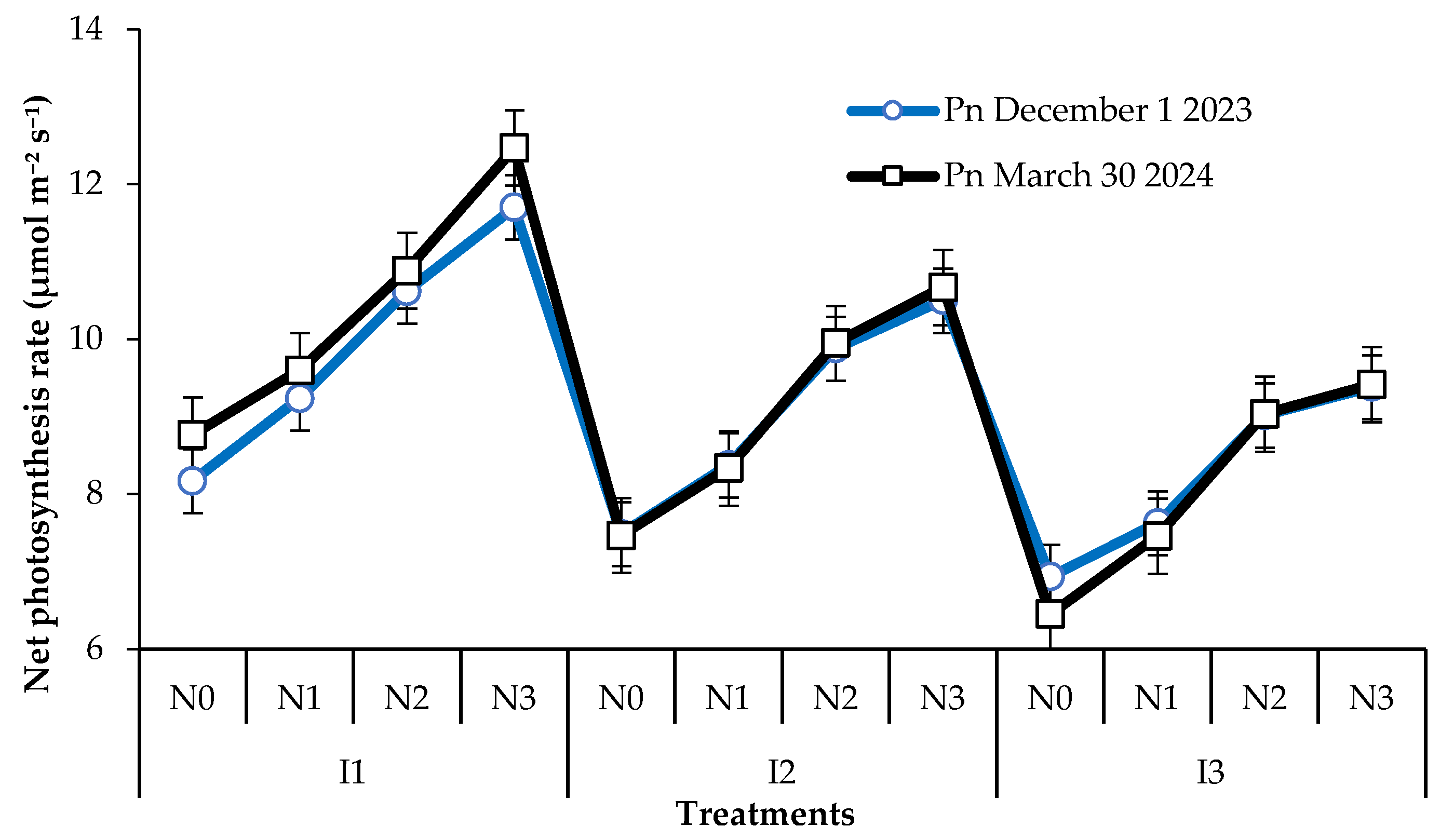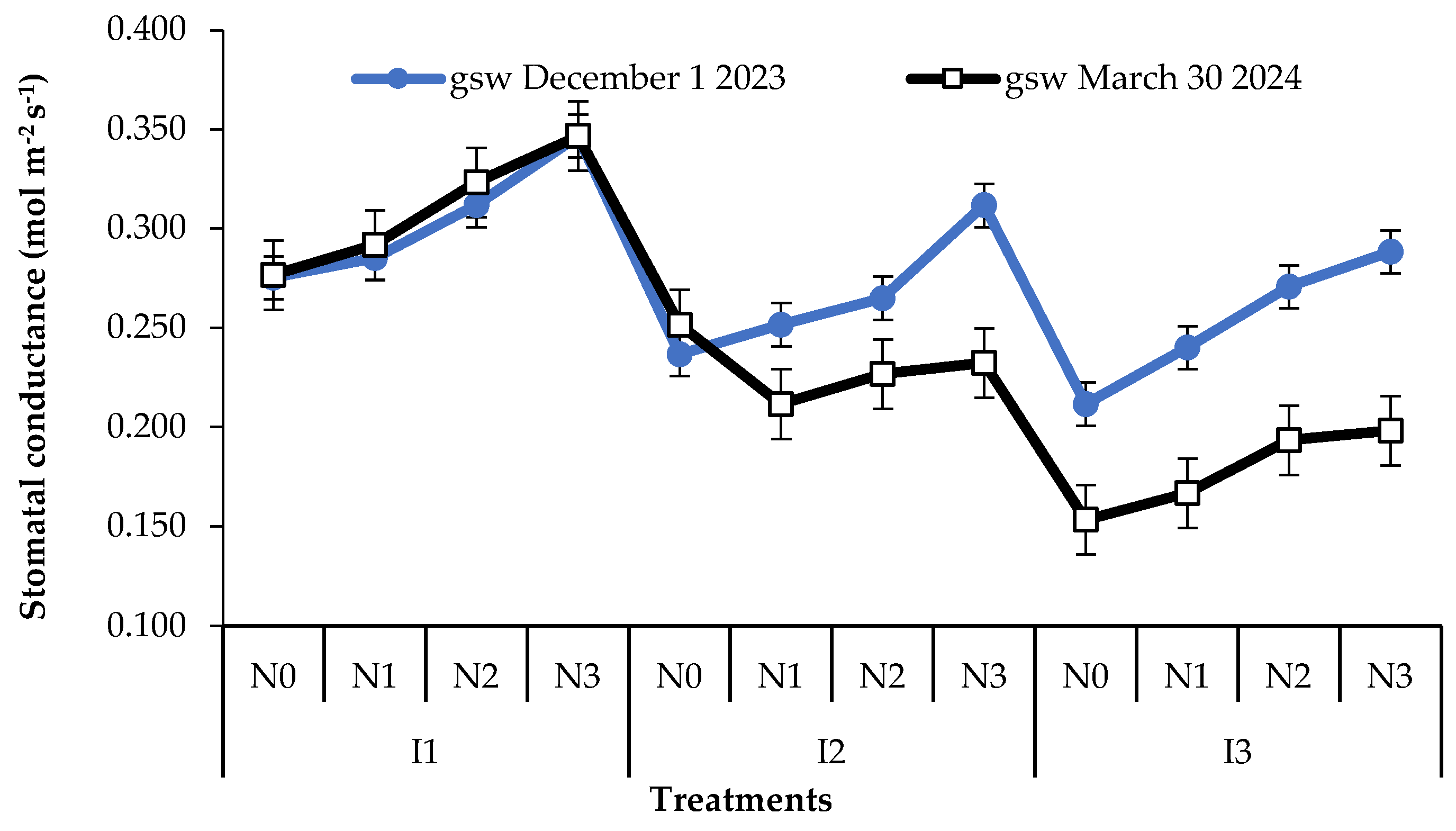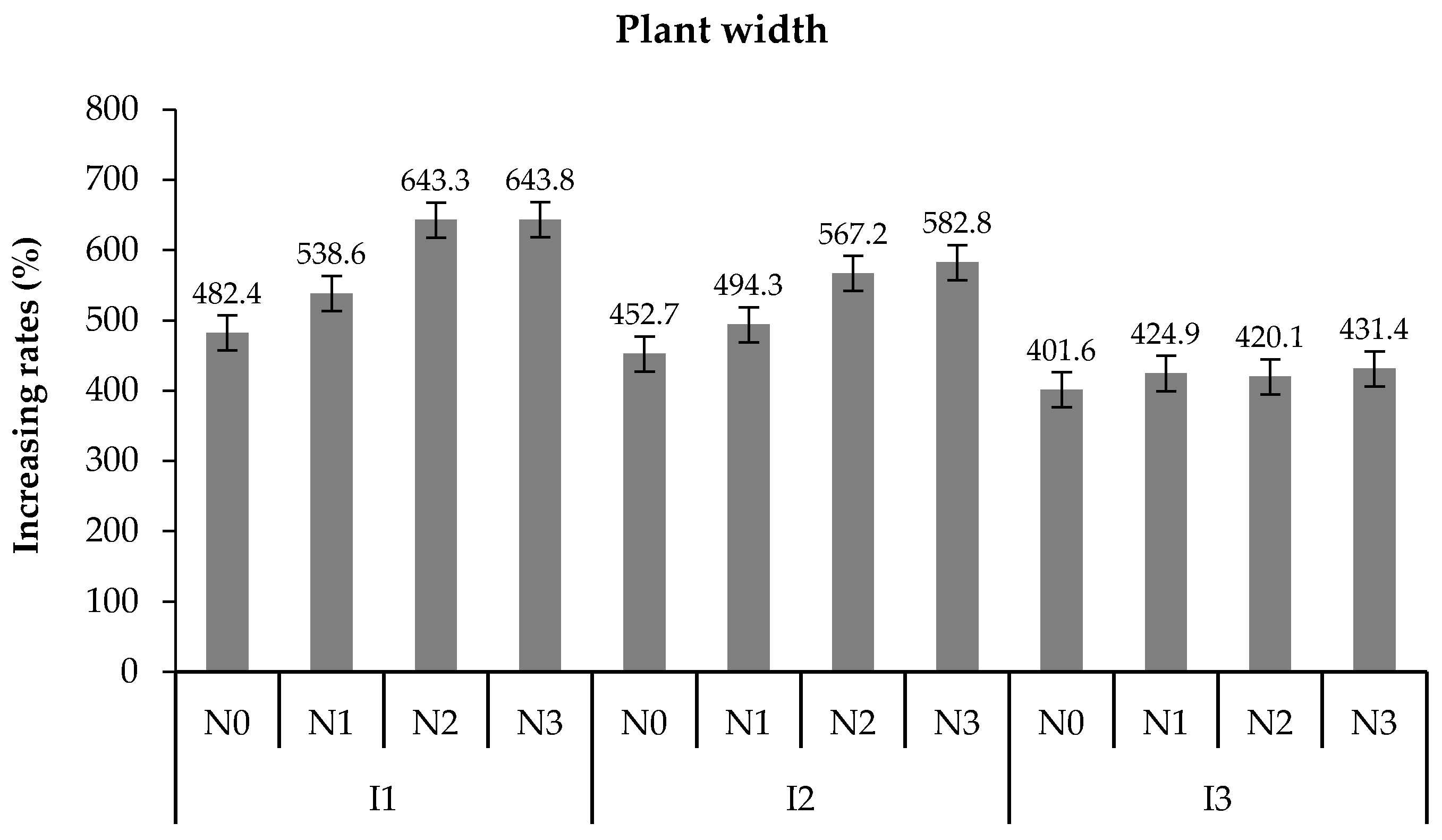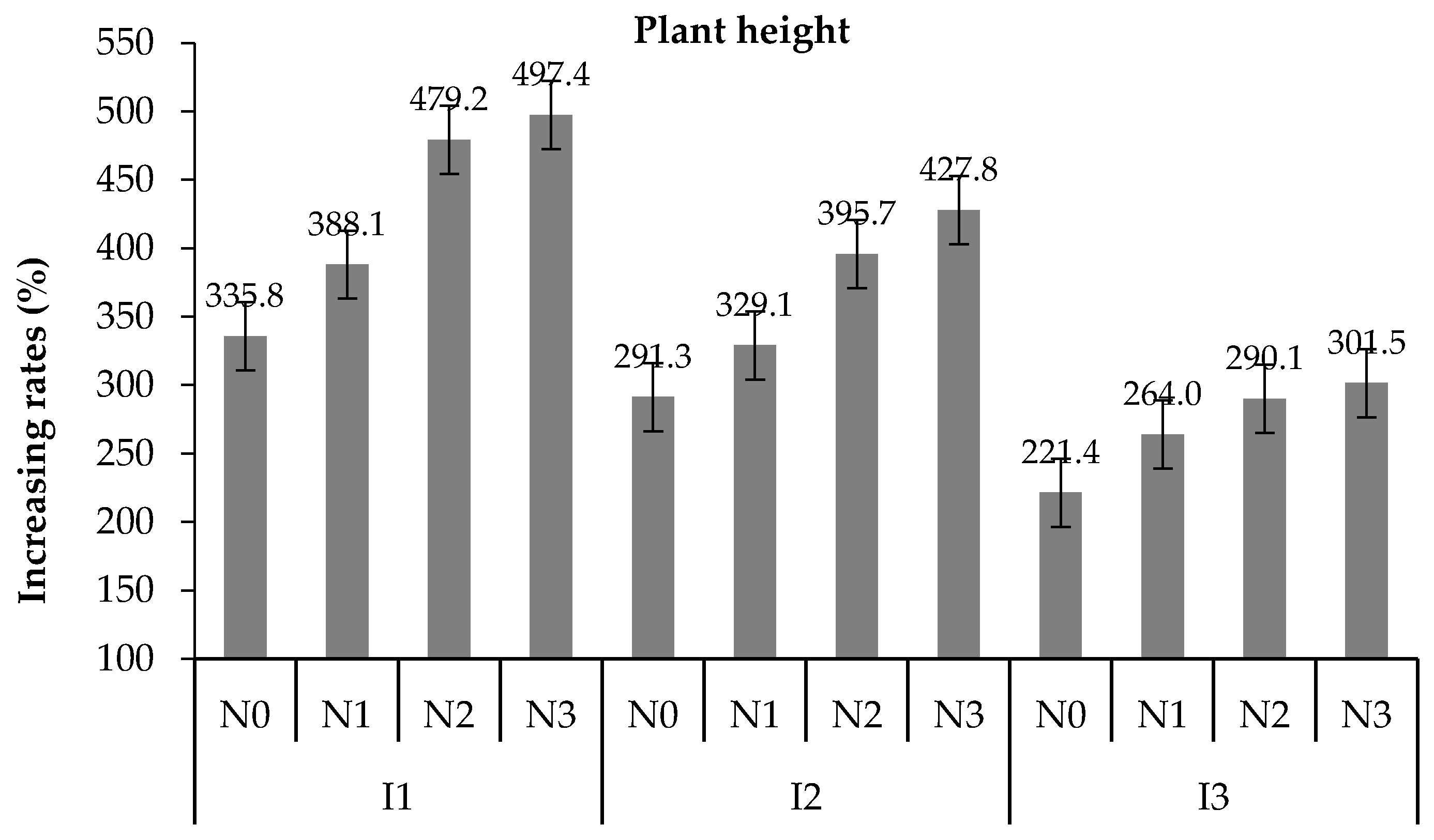The plant water consumption values varied depending on the amount of irrigation water. As the amounts of irrigation water were higher than the other treatments, the highest plant water consumption was provided by the I
1 treatments. I
1 had higher water consumption than the other treatments, in which similar nitrogen doses were applied. Demirel et al. (2020) stated that cyclamen plants used higher amounts of irrigation water depending on different irrigation levels [
31]. The lowest water consumption was obtained from plants to which was applied 25% of the irrigation water of the plants fully irrigated in their study. Plant water consumption increased in the plants of the I
1 treatments towards the end of the growing season (
Figure 1). This result showed that cyclamen plants continued to grow even if they were at the end of the growing season. Cyclamen plants are perennial, and they continue to grow after flowering. This means that the flowering period continues to the end of the year. Since the plants continue to grow, they can consume more water. The planned water consumption decreased towards the end of the season in the cyclamen plants of the other treatments. The reason may be that this decreases the vegetative growth and stops the growth of plants due to less applied irrigation water. The increase in nitrogen dose provided more vegetative growth [
27]. When vegetative growth is strong, plants start to use higher amounts of irrigation water. The different nitrogen doses applied to plants affected the amounts of irrigation water applied; increasing nitrogen doses provided higher plant water consumption [
32]. Plant water consumption increased with the nitrogen doses even if the plants had a similar irrigation program applied. This situation can be interpreted as nitrogen, which is one of the important nutrient elements for plants, significantly increasing the vegetative development of the plant. Therefore, the water consumption of the plant increases.
There are very few comparable studies on the
Pn and
gsw results of cyclamen plants. All the water stress levels applied in this study decreased the
Pn and
gsw. Stomatal closure is one of the first responses to drought stress, which results in a declining rate of photosynthesis. Athar and Ashraf (2005) reported that water stress lowers the water potential of the growing plants, leading to dehydration and decreased stomatal conductance [
33]. Anjum et al. (2011) stated that water stress levels negatively affected the
Pn [
34]. Many studies have shown decreased photosynthetic activity under drought stress due to stomatal or non-stomatal mechanisms [
35,
36,
37]. Yıldırım et al. (2009) reported that if the amount of irrigation water applied is less than the cyclamen needs, it could negatively affect the morphological and physiological characteristics of the plant [
38]. Drought stress inhibits dry matter production largely through its inhibitory effects on leaf expansion, leaf development, and the consequently reduced light interception [
39]. Water stress affected the stomatal closure and reduced photosynthesis of New Guinea Impatiens [
40]. Plants have responses to water stress by reducing the
Pn and
gsw. Similar
Pn and
gsw results were also provided by this study. The photosynthetic capacity of leaves is related to the nitrogen content primarily [
41]. Nitrogen deficiency in plants negatively affects photosynthesis [
27]. Ay and İbrikçi (2020) stated that nitrogen deficiency leads to decreased photosynthesis [
42]. N increases vegetative growth and plant branching. In turn, more leaves are produced in the plant, increasing the photosynthetic level [
43]. Higher N content in leaves is associated with higher chlorophyll content and increased chloroplast activity and thus increased photosynthetic productivity [
44]. Application of optimum N improves various physiological and metabolic processes, such as photosynthesis, carbon, and nitrogen metabolism, and increases photosynthesis activity [
45]. Appropriate amounts of nitrogen fertilizer applications provide higher photosynthetic activity in the plant [
46]. The relationship between nitrogen and photosynthesis depends on plant species and varieties. Akman (2001) stated that N increased photosynthetic activity in barley, but the N application of more than 16 kg da
−1 did not affect photosynthetic activity [
47]. Tóth et al. (2002) performed a study to determine the effect of the different N doses (30, 60, 90, 120, and 150 N kg ha
−1) on the photosynthesis of maize plants and found no significant differences [
48]. Cechin and De Fátima Fumis (2004) obtained the finding that photosynthesis was remarkably increased by high nitrogen supply for sunflowers [
49]. They determined that N did not statistically affect stomatal conductance. Reddy et al. (1996) determined that net photosynthetic rate and stomatal conductance of cotton were positively correlated with leaf N concentration [
50]. The plants had different responses to increasing N doses. Increasing nitrogen doses positively affected both the
Pn and
gsw of cyclamen in this study. Each increase in nitrogen doses provided higher
Pn and
gsw results. Strong vegetative growth means healthy plants. The reason may be the better vegetative growth, since nitrogen supported vegetative growth. That is why nitrogen applications with 30 kg da
−1 should be increased in the following studies. Although nitrogen applications increased plant vegetative development, it can be said that the amount of irrigation water in the effective root zone had a more effective effect on plant height in cyclamen. Nitrogen supports an increase in the growth of plants. When there is enough water around in the effective root zone area, nitrogen has a more positive effect due to water having a transporting effect on plant nutrient elements from root to stem, leaves, etc. If there is a lack of water in the root zone area, this situation has a negative effect on the transport of plant nutrients from root to stem, leaves, etc. Even if a sufficient amount of nitrogen is applied, plants cannot uptake nitrogen or other elements. The reason for less vegetative development in I
3 treatments can be explained in this way. Some researchers stated that increasing nitrogen doses provided higher plant height [
51,
52]. Salman et al. (2016) reported that the plant height of
C. persicum Mill. was between 5 and 20 cm [
8]. The plant height results obtained from the study were between these values. The plant width in conditions without water stress increased as the nitrogen level increased. In the treatments with no water stress, the cyclamen plant responded positively to the increasing nitrogen dose by increasing the plant width value. The effects of nitrogen doses applied to cyclamen under severe stress applications (I
3 treatment) on plant width were similar. In other words, in cultivation carried out with irrigation at this level, the application of nitrogen fertilizer at the lowest (N
1) level will be sufficient to obtain the highest plant width. In this case, savings in nitrogen fertilizers will also be possible. A common adverse effect of water stress on crop plants is the reduction in vegetative growth [
42,
53]. One of the important effects of water deficiency in the effective root zone is the decrease in vegetative growth due to the decrease in photosynthesis rate [
54]. Yıldırım et al. (2009) reported that water deficit treatments in C. hederifolium had positive effects on some vegetative growth parameters like fresh root weight, stalk length, and the number of stalks [
38]. The results did not match with those of this study. The reason for the different results may be the use of different species (
C. persicum Mill. and
C. hederifolium Aiton.) and different irrigation treatments in these studies. The increasing rates of plant width obtained from the I
3 treatments varied from 401.6 to 431.4, and they were close. This means that even less irrigation water and lower nitrogen applications provide vegetative growth. Similar results can also be said for plant height and leaf stalk length.
C. persicum Mill. can be grown in water stress conditions with a lower amount of nitrogen fertilizer.
In this study, it was found that increasing nitrogen doses increased the number of flowers. It can be said that increasing nitrogen doses increases vegetative development and that increasing vegetative development positively affects flower formation. The highest number of flowers was obtained from N
2 and N
3 nitrogen doses. If a high number of flowers are targeted in cyclamen growing, irrigation should be conducted without creating water stress conditions (I
1), and N
2 and N
3 nitrogen doses should be applied. N
2 application can be recommended to growers to save on nitrogenous fertilizers for providing the highest number of flowers. The I
2N
3 treatment with moderate water stress and the highest nitrogen dose, and the I
1N
2 treatment with no water stress and nitrogen applied at the N
2 level were in similar statistical groups. This result showed that if the amount of the irrigation water source is sufficient, the same number of flowers will be obtained by using less nitrogen fertilizer (I
1N
2). Water stress negatively affected New Guinea Impatiens and limited total flowering [
33]. Flower stalks of chrysanthemum, another ornamental plant, were affected by different irrigation water amounts [
56]. The longest flower stalk lengths were obtained from the treatment that applied the highest amount of irrigation water. Yazıcı et al. (2020) reported that nitrogen applications increased the flower stalk of
Dahlia spp. [
57].
